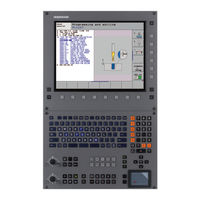HEIDENHAIN iTNC 530 E Manuals
Manuals and User Guides for HEIDENHAIN iTNC 530 E. We have 2 HEIDENHAIN iTNC 530 E manuals available for free PDF download: User Manual
HEIDENHAIN iTNC 530 E User Manual (689 pages)
Conversational Programming
Brand: HEIDENHAIN
|
Category: Control Panel
|
Size: 25 MB
Table of Contents
-
-
Introduction37
-
The Itnc38
-
-
-
-
-
Data Backup96
-
-
-
Deleting a File106
-
Tagging Files107
-
Renaming a File108
-
-
Adding Comments133
-
-
Display Help141
-
Show Error List142
-
Window Contents143
-
-
-
-
Feed Rate F162
-
Spindle Speed S163
-
-
Tool Data164
-
Tool Length L164
-
Tool Radius R165
-
Tool Change176
-
-
-
-
Path Functions200
-
Tool Movements200
-
Straight Line L214
-
Circle Center CC217
-
Straight Line Lp227
-
Auxiliary Points242
-
Relative Data243
-
Basic Settings253
-
Layer Settings254
-
Datum Specifying255
-
Zoom Function258
-
-
-
-
Point Tables298
-
Drilling (Cycle)307
-
Reaming (Cycle)309
-
Boring (Cycle)311
-
Sl Cycles397
-
-
D Data (Cycle)442
-
-
Special Cycles476
-
Position Display484
-
Label Lbl518
-
Nesting Depth521
-
Types of Nesting521
-
-
-
Test Run593
-
Program Run596
-
MOD Functions607
-
Mod Function608
-
Code Numbers611
-
Introduction617
-
-
Network Settings675
-
Overview Tables685
-
Status Displays687
-
Example689
-
Advertisement
HEIDENHAIN iTNC 530 E User Manual (514 pages)
Cycle Programming
Brand: HEIDENHAIN
|
Category: Control Panel
|
Size: 10 MB
Table of Contents
-
-
Application58
-
Function66
-
Point Tables66
-
-
-
Cycle Run75
-
Drilling75
-
Reaming77
-
Boring79
-
Back Boring87
-
Bore Milling95
-
Tapping New107
-
Rigid Tapping109
-
Prerequisites115
-
Thread Milling117
-
Circular Pocket146
-
Slot Milling150
-
Circular Slot155
-
Rectangular Stud160
-
Circular Stud164
-
Circular Pattern173
-
Linear Pattern176
-
SL Cycles182
-
Contour Geometry185
-
Contour Data190
-
Pilot Drilling192
-
Rough-Out194
-
Floor Finishing198
-
Side Finishing199
-
Contour Train201
-
Trochoidal Slot205
-
Cylinder Surface221
-
Run 3-D Data255
-
Ruled Surface259
-
Face Milling263
-
Datum Shift274
-
Datum Setting281
-
Mirror Image282
-
Rotation284
-
Scaling Factor286
-
Working Plane290
-
Dwell Time303
-
Program Call304
-
Cycle Function306
-
Tolerance307
-
Cycle Parameters310
-
-
Basic Rotation322
-
Basic Rotation331
-
Tool Monitoring400
-
Ref. Plane402
-
Measure Angle405
-
Measure Hole408
-
Measure Plane437
-
Calibrate Ts447
-
Measuring449
-
-
Cycle Run451
-
Measuring in 3-D451
-
Cycle Parameters452
-
Log Function465
-
-
Backlash473
-
Error Outputs480
-
Fixed Cycles509
Advertisement
Related Products
- HEIDENHAIN ITNC 530 - PILOT SMART NC
- HEIDENHAIN ITNC 530 - CYCLE PROGRAMMING
- HEIDENHAIN ITNC 530 - CONVERSATIONAL PROGRAMMING
- HEIDENHAIN iTNC 530 HSCI
- HEIDENHAIN IK 5000 QUADRA-CHEK
- HEIDENHAIN QUADRA-CHEK IK 559 Series
- HEIDENHAIN ID 344980-01
- HEIDENHAIN ID 344980-02
- HEIDENHAIN ID 331143-04
- HEIDENHAIN IOB 49

